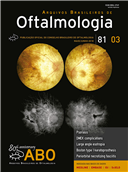Purpose: To evaluate the efficacy of prostaglandin antagonists on blood-retinal barrier breakdown induced by anterior segment intraocular simulated surgery.
Methods: Rats were randomly assigned to a negative control group, model group, nonsteroidal anti-inflammatory drugs prophylactic treatment group, nonsteroidal anti-inflammatory drugs treatment group, corticosteroid prophylactic treatment group, and corticosteroid treatment group. Four hours and 48h after modeling, the concentrations of PGE1, PGE2, and PGF2 α in the aqueous humor and vitreous body of the rat model were visualized using ELISA. The integrity of the blood-retinal barrier was quantitatively measured using Evan’s blue as a tracer.
Results: Four hours after modeling, the concentrations of PGE1, PGE2, and PGF2α in the aqueous humor and vitreous body in the negative control group and the nonsteroidal anti-inflammatory drugs prophylactic treatment group were significantly lower than those in the model group. The concentrations of PGE1, PGE2, and PGF2α in the aqueous humor and vitreous body in the corticosteroid prophylactic treatment group were higher than those in the negative control group and the nonsteroidal anti-inflammatory drugs prophylactic treatment group. Forty-eight hours after modeling, the concentrations of PGE1, PGE2, and PGF2α in the aqueous humor and vitreous body in the nonsteroidal anti-inflammatory drugs prophylactic treatment group, nonsteroidal anti-inflammatory drugs treatment group, corticosteroid prophylactic treatment group, and corticosteroid treatment group were lower than those in the model group, but higher than those in the negative group. Retinal Evan’s blue leakage in the nonsteroidal anti-inflammatory drugs prophylactic treatment group was higher than that in the negative control group, and lower than those in the nonsteroidal anti-inflammatory drugs treatment group, corticosteroid prophylactic treatment group, corticosteroid treatment group, and model group. Retinal Evan’s blue leakage in the nonsteroidal anti-inflammatory drugs treatment group, corticosteroid prophylactic treatment group, and corticosteroid treatment group were lower than those in the model group.
Conclusions: This study confirms that prostaglandin antagonists can relieve blood-retinal barrier breakdown in a rat model and that nonsteroidal anti-inflammatory drugs prophylactic treatment can achieve better efficacy.
Keywords: blood-retinal barrier; surgery; Prostaglandin antagonists; anti-inflammatory agents, non-steroidal; Adrenal cortex hormones; Anterior eye segment/surgery; Rats
